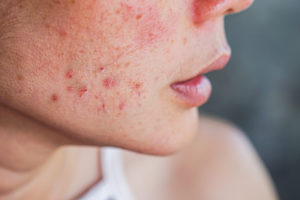
Often, the skin can be a window to what is occurring inside your body. For women with polycystic ovary syndrome, or PCOS, this this may mean acne, hair loss, excessive facial or body hair growth, dark patches on the skin, or any combination of these issues.
What is PCOS?
Skin and hair issues can be the most readily perceptible features of PCOS, and thus sometimes the reason for seeking medical care. However, features of PCOS also include menstrual irregularities, polycystic ovaries (when the ovaries develop multiple small follicles and do not regularly release eggs), obesity, and insulin resistance (when cells do not respond well to insulin).
The cause of PCOS is not entirely understood, but scientific evidence points to hormonal imbalances, specifically excess testosterone (also known as hyperandrogenism) and insulin resistance. PCOS is the most common cause of infertility in women. The hormonal imbalances in PCOS disrupt the process of ovulation, and without ovulation pregnancy is not possible. PCOS exists on a spectrum, meaning not every woman with PCOS has the same signs and symptoms. Because of the variation in characteristics of this syndrome, it can be difficult to diagnose.
How do I know if I have PCOS?
There is no one specific test that can be used to diagnose PCOS, so a thoughtful and thorough workup, including lab tests and imaging, is needed. Lab tests typically involve measuring levels of various hormones, such as androgens. Imaging tests may include ultrasound of the ovaries. Seeking care from an experienced team, including primary care physicians, gynecologists, endocrinologists, and dermatologists, can establish the diagnosis.
What are the skin manifestations of PCOS?
PCOS-related acne often flares on the lower face, including the jawline, chin, and upper neck. Although not a hard and fast rule, these areas are considered to be a hormonal pattern for acne. Women with PCOS may notice that acne lesions are deeper, larger, and slower to resolve. Acne in PCOS usually worsens around the time of menstrual periods. Dermatologists often recommend the use of oral contraceptive pills or a medication called spironolactone to treat this type of acne. These treatments, when used in the right patients who have no contraindications to them, can be very helpful in clearing acne.
Hirsutism, or excessive hair growth in places where hair is usually absent or minimal, is another dermatologic sign of PCOS. Common areas of hirsutism include the chin, neck, abdomen, chest, or back. On the scalp, however, balding or thinning of the hair can be seen. Both of these hair issues are driven by an excess of testosterone.
Occasionally, another skin condition appears called acanthosis nigricans, which are dark, velvety areas of skin, usually in skin creases such as around the neck and underarms. This type of skin condition is also associated with insulin resistance, and may be due to stimulation of skin cells by insulin, causing them to overgrow.
Treatment options and a tailored approach
Although there is no cure for PCOS, there are many treatment options for managing various symptoms of this syndrome. The types of treatments used depend on a woman’s priorities and symptoms. For example, being at a healthy weight can lead to improvement of symptoms, so lifestyle modifications to nutrition and exercise may help. Hirsutism can be treated with laser hair removal or electrolysis. Some patients may try birth control pills to improve menstrual regularity. Metformin, a commonly used medication for diabetes, can be used to help improve the body’s response to insulin.
Treatment planning is tailored to each person and depends on whether or not pregnancy is a short-term goal. Certain medications, including spironolactone and retinoids for acne, should be avoided if a woman is trying to become pregnant.
